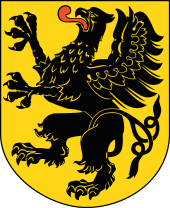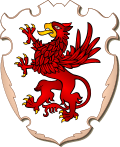Coat of arms of the Pomeranian Voivodeship



The resolution regarding the coat of arms of the Pomeranian Voivodeship was taken on by the Sejmik of the Pomeranian Voivodship in Gdańsk.
On a yellow background, the image of a black Griffin of Pomeranian-Wendish origin, with raised wings and a red tongue out of the mouth.
The first example of the coat of arms is a 16th Century image of the griffin, which is in the Presbitry of the Oliwa Cathedral.
The image of the black griffin looking towards the right, on a yellow background, is also known for being the coat of arms of Kashubians. Therefore, these two coats of arms are often identified; according to some sources, as being one and an identical coat of arms.
The creator of the coat of arms is Wawrzyniec Samp.
Polish-Lithuanian Commonwealth
Between the years of 1454 and 1795, the coat of arms of the Pomeranian Voivodship was represented by a red griffin on a white background.
Second Polish Republic
The coat of arms did alter substantially, "the coat of arms still included a red griffin looking to the left on a white background. The front legs were positioned as if they were to run, wings as if they were preparing to flight, the tongue was hanging out, and a crown on the head". There was a certain amount of controversy regarding the griffin being the coat of arms, as the former Chełmińskie Voivodeship had now been incorporated within the Pomeranian Voivodeship, whose coat of arms was a sworded eagle.
